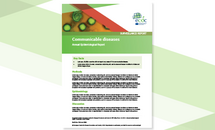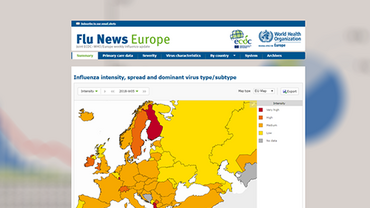Seasonal influenza - Annual Epidemiological Report for 2019–2020
Influenza activity started in week 45/2019 and returned to baseline levels in week 13/2020, earlier than previous seasons. Influenza viruses circulated at high levels between weeks 52/2019 and 10/2020 (based on increased proportions (40% and above) of sentinel specimens testing positive for influenza viruses). This is comparable to previous seasons.
Executive summary
- Similar proportions of influenza A(H1)pdm09, A(H3) and B/Victoria were detected throughout the season. B/Victoria lineage viruses have greatly outnumbered those of the B/Yamagata lineage.
- Different patterns of dominant type and A subtypes were observed among the countries. Early on, circulation of A(H3) was higher and later in the season increased proportions of A(H1)pdmp9 and B/Victoria viruses were observed.
- Characterised A(H3) viruses fell mainly in clades 3C.3a and 3C.2a1b, A(H1)pdm09 viruses fell mainly in clade 6B.1A5A, while the majority of B/Victoria lineage viruses fell in the Δ162-164 triple deletion subgroup.
- The majority of severe cases reported this season were due to influenza virus type A infection and these mostly occurred in persons older than 40 years.
- The majority of deceased hospitalised influenza patients were 65 years and older and had influenza A virus infection.
- During the period of high influenza virus circulation in early January and February, a slight excess mortality from all causes was observed, possibly related to influenza, while later in the season the excess mortality was driven by COVID-19.
- The vast majority of influenza viruses tested were susceptible to neuraminidase inhibitors.
- A moderately good vaccine effectiveness was observed, which was higher for type B and A(H1)pdm09 viruses.
Download

Seasonal influenza - Annual Epidemiological Report for 2019–2020 - EN - [PDF-1.13 MB]






